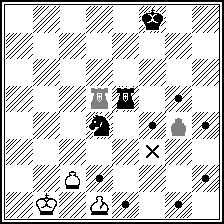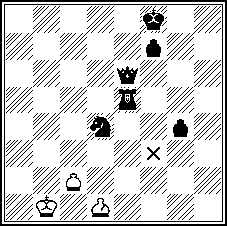Piececlopedia: Mimics
Mimics are pieces which are able to imititate the movement of other pieces. They may, or may not, have movement capabilities of their own. Before getting into specifics, let's define some terms.
- Dynamic
- A type of piece which has movement capabilities that change throughout
the progress of a single game.
A trivial example would be the pawn from orthodox chess.
The initial movement capabilities of a pawn are different than its subsequent
movement capabilities -- it may move two squares on its first move. Also, when
the pawn promotes, its movement capabilities change.
A more definitive example would be from Flip Chess, where pieces are "two sided" with each side denoting a different movement capability. Pieces flip during the progress of the game.
- Mimic
- A dynamic piece which (generally) has no movement capabilites of its own, but imitates the move of one or more other pieces.
- Mime
- A Mimic that imitates based on its position.
- Imitator
- A Mimic that imitates based on some previous event (eg. the last moved piece).
In keeping with John William Brown's Meta-Chess convention for categorizing pieces, I have developed the following terminology for describing Mimics.
Positional Mimics (or Mimes)
A Mime takes on the movement capabilities of any pieces either protect the square it is on, or attack the square it is on. It is positional in the sense that its movement capabilities depend on its position relative to the positions of the other pieces.
Listed below are four possible ways a Mime can operate:
- Moves as attacker(s) move
- Moves as protector(s) move
- Captures as attacker(s) capture
- Captures as protector(s) capture
The word "move" above is used in the non-capturing sense.
By combining the above capabilities we may construct four different Mime pieces:
1 and 3: Reflecting Mime
1 and 4: Obverse Mime
2 and 3: Balanced Mime
2 and 4: Supported Mime
Reflecting Mime (rM)
Moves as attacker(s) move, captures as attacker(s) capture. This Mime is called reflecting because it reflects back the attacks and moves of its attackers. This piece was actually invented by David L. Brown (problemist and columnist for the USCF's Chess Life magazine) under the name Orphan.
The white Reflecting Mime at f3 is represented by the X. In this position, the rM can move and capture as a pawn or Knight. The dots show where it can move to, and the greyed pieces are the pieces it may capture.
Obverse Mime (oM)
Moves as attacker(s) move, captures as protector(s) capture. This Mime is called obverse because I didn't know what else to call it!
The white Obverse Mime at f3 is represented by the X. In this position, the oM can capture as a Bishop or move as a Knight or pawn. The dots show where it can move to, and the greyed pieces are the pieces it may capture.
Balanced Mime (bM)
Moves as protector(s) move, captures as attacker(s) capture. This Mime is called balanced because it is a balance of attacking and defending pieces.
The white Balanced Mime at f3 is represented by the X. In this position, the bM can capture as a Knight or pawn or move as a Bishop. The dots show where it can move to, and the greyed pieces are the pieces it may capture.
Supported Mime (sM)
Moves as protector(s) move, captures as protector(s) capture. This Mime is called supported because its movement is completed determined by those pieces supporting it. This piece was actually invented by David L. Brown (problemist and columnist for the USCF's Chess Life magazine) under the name Friend.
The white Supported Mime at f3 is represented by the X. In this position, the sM can capture or move as a Bishop. The dots show where it can move to, and the greyed pieces are the pieces it may capture.
Temporal Mimics (or Imitators)
An imitator takes on the movement capabilities of the opponent's last moved piece. An imitator keeps it movement capabilities until the opponent makes his next move. This rule is necessary when mixing Imitators and Mimes in a single game.
Literal Imitator (lI)
Mimics the move of the last opponent piece played. May only capture if the last opponent piece captured. The move itself is mimicked, not the movement capability. This applies especially in the case of combinational pieces (ie. pieces whose movement capabilities are the combination of two or more primitive pieces). The Literal Imitator isn't quite totally literal though -- it does not have to move the same number of squares or in the same direction as the imitated piece. Such a limited piece would have extremely little value.
 Before ... Qd5 |
 After ... Qd5 |
Strict Imitator (sI)
Mimics the move of the last opponent piece played. May only capture if the last opponent piece captured. This piece is equivalent to the Jester from Jester chess.
 Before ... Qd5 |
 After ... Qd5 |
Generic Imitator (gI)
Moves and captures as if it were a piece of the type the opponent last moved. This applies to movement and capture capabilities, but does not apply to special capabilities such as pawn promotion (if a pawn is being imitated), or moving into check (if a King is being imitated). The Imitator does not take on the identity of the piece, it simply is able to move and capture like it.
 Before ... Qd5 |
 After ... Qd5 |
Morose Imitators
Moves and captures as if it were a piece of the type most recently captured. There are three flavors of Morose Imitator (or Undertaker):
- Friendly (fU): moves and captures as it it were a piece of the type most recently lost by the owning player.
- Hostile (hU): moves and captures as if it were a piece of the type most recently lost by the enemy player.
- Neutral (nU): moves and captures as if it were a piece of the type most recently captured, irrespective of the owning player.
Imperfect Mimics
An Imperfect Mimic is any Mimic that, instead of mimicking a move, mimics a variation of the move. For example, let's make up a piece called the "Court Jester". It's a generic imitator -- however, instead of imitating the move, it mocks the move. So instead of moving like a Bihsop (if a Bishop had just moved), it would move like a "stumbling Bishop", that is, a normal bishop move, except that it could only land or capture on the first square, or every two squares thereafter (this is a form of Lame Bishop -- from John William Brown's Meta-Chess).The "Mimicking" Prefix (y-)
A piece may be said to be mimicking when it has the ability to imitate the movement of any piece that it threatens via its normal capturing move. This is an example of a Mimic which does have a movement capability of its own.

The white Mimicking Bishop (yB) at f3 is represented by an X. Since it is attacking the black Rook at d5 and the black pawn, it may move/capture like a Rook or a pawn. And of course, it still may move/capture as a Bishop. The dots show where it can move to, and the greyed pieces are the pieces it may capture.
Why use Mimics?
Adding a Mimic piece to a game tends to make the game more dynamic and less predictable. The entire dynamic of a position can be completely changed simply based on the piece one decides to move. Longer term planning becomes much more difficult. In games with more than one type of Mimic, the complications that can result may be difficult to resolve. Therefore, it is suggested that game designers restrict themselves to a single type of Mimic piece per side.
Mimics have been used in several chess variants:
- Jester Chess (the Jester)
- Dragons, Archers and Oxen (the Dragon)
- Ultima (the Chameleon)
- (probably many more...)
In each of these games, the type of Mimic used is unique, although certainly the Jester is basically a Strict Imitator, and the Dragon is basically a Generic Imitator with some specializations. Each game has its own requirements. Hopefully though, having a general starting point for the design of a Mimic type piece will be helpful for new variant designers or problemists.
Written by David Howe.
WWW page created: May 30, 1999.
